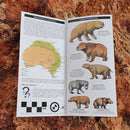Description
A folding pocket guide to Australian megafauna species. This convenient guide is a portable source of practical information for palaeontologists of all ages.
The ancestors of the Australian marsupial fauna originated in South America and arrived by dispersal across Gondwana from 64 to 40 million years ago. Megafauna gradually emerged during the Oligocene Epoch, around 33 million years ago, in response to the wide-open landscapes and colder, drier climates in Australia. By the Late Pleistocene period Australia was covered in lush vegetation that extended from wet rainforests in the north to eucalypt forests in the south. This environment was capable of sustaining large marsupials, placentals, birds, snakes, lizards and crocodiles. The many megafauna sites across Australia, typically in caves or surface features, suggest that megafauna like Procoptodon, Zygomaturus and Thylacoleo thrived in these environments. While many of Australia's megafauna species are extinct, some survived. Australian living megafauna include emus, red kangaroos, common wombats and crocodiles.
This beautiful guide has been illustrated by palaeo-artist Sante Mazzei and is an easy to read resource on some of the many scientifically-described megafauna found in Australia. This guide includes each animals phonetic pronunciation, description and other exciting facts. Learn more about Yurlunggur, Wakaleo, Protemnodon, Obdurodon, Euryzygoma, Phoeniconotius and many more!
This durable, lightweight, pocket-sized folding guide is an excellent source of portable information and ideal for field use by visitors and residents alike. Made in Australia.
-
Language English
- Pamphlet Eight pages
- Reading age Ten years and older
- Dimensions 396 x 210mm
Payment & Security
Your payment information is processed securely. We do not store credit card details nor have access to your credit card information.










